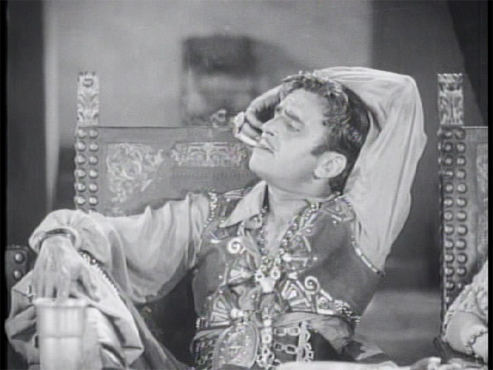
Reviews of silent film releases on home video.
Copyright © 1999-2024 by Carl Bennett
and the Silent Era Company.
All Rights Reserved. |
|
The Gaucho
(1927)
|
The Gaucho (1927) has always been one of our favorite of several Douglas Fairbanks films. Doug’s performance is enthusiastic and entertaining, as usual, and the film is chock full of Doug’s little parlor tricks and displays of physical prowess. Lupe Velez is beautiful and hot-blooded, and she is a welcome match in energy to Doug, who was usually surrounded by limp heroines. While the film feels somewhat similar in feel and plot to other Fairbanks films, especially The Mark of Zorro (1920), is has a delicious energy that is palpable and a satisfying storyline that warrants multiple viewings.
A young girl living in the mountains of South America suffers a terrible fall, but she does not die through a miracle of the Virgin Mary. A shrine is erected at the grotto where it happened. Around the shrine rises a city, The City of the Miracle, that draws religious believers from all over. The city prospers. The City of the Miracle draws not only the greedy and corrupt official Ruiz’s men but also the film’s anti-hero, The Gaucho. He drives out Ruiz’s men and controls the city. One of Ruiz’s lieutenants coaxes The Gaucho’s lieutenant to treachery. The conspirators plot to capture The Gaucho for the 10,000 peso reward. The Gaucho can oppose the soldiers of Ruiz but cannot face the gaze of the madonna of the shrine. Some big changes are in store for The Gaucho. Things all work out, but in way that is not anticipated.
There are a number of impressive visual effects and stylish touches. For instance, there is something very gothic about the touch of the leper; a style that anticipates the Universal horror films of the 1930s and 1940s. There is a nice shimmering effect in the radiant halo of the Virgin Mary. The film features a number of impressive glass shots that creates the effect of high mountainous views. And the sets of the City of the Miracle are almost as awe-inspirating (for their time) as Fairbanks’ sets for Robin Hood (1922) and The Thief of Bagdad (1924).
— Carl Bennett
|
 Kino on Video Kino on Video
2001 DVD edition
The Gaucho (1927), black & white, 96 minutes, not rated,
with The Mystery of the Leaping Fish (1916), black & white, 26 minutes, not rated.
Kino International, K215, UPC 7-38329-02152-8.
One single-sided, single-layered, Region 0 NTSC DVD disc; 1.33:1 aspect ratio picture in full-frame 4:3 (720 x 480 pixels) interlaced scan image encoded in SDR MPEG-2 format at 4.0 Mbps average video bit rate (capable of progressive scan upscaling to ? fps); Dolby Digital (AC3) 2.0 stereo sound encoded at 192 Kbps audio bit rate; English language intertitles, no foreign language subtitles; 15 chapter stops; standard DVD keepcase; $29.95.
Release date: 9 October 2001.
Country of origin: USA
Ratings (1-10): video: 9 / audio: 7 / additional content: 8 / overall: 8.
|

This DVD edition of The Gaucho is presented here as produced for home video by David Shepard and released by Kino Intenrational on videotape in 1996. The video transfer utilizes a print that is moderately speckled and scratched, with scuffing that fluctuates from slight to very scruffed in some places in the film. The print appears to be a very-good but slightly worn 35mm print or a very-good original 16mm reduction print. The transfer speed runs slightly fast and the picture is tightly cropped. The player credits will be cropped on the sides by some televisions, as will some of the intertitles.
A lively and pleasing music score has been composed and performed on synthesizers by Sydney Jill Lehman. We just wish that a small group of musicians playing acoustic instruments had recorded the score or that more realistic sounds could have been sampled to take the artificial timbre out of some of the electronic instruments’ sounds.
A supplementary section contains a reproduction of the front cover and a few brief text articles from the original souvenir program for The Gaucho. The three articles are entitled, “When Fairbanks Gets an Idea!,” “Things That Only Fairbanks Can Do” and “What Is a Gaucho?” The article on special effects in the film includes a sidebar from edition producer Bret Wood detailing how some of the effects shots were achieved. The story about gauchos includes a brief video of one of the prop boleadoras used by Fairbanks in the film.
The highlight of the supplemental section is the home video premiere of a new transfer from a very good to excellent 35mm print of Fairbanks’ bizarre comedy short The Mystery of the Leaping Fish (1916).
We heartily recommend this fine home video edition of one for Douglas Fairbanks’ best films and another that is, beyond doubt or argument, his strangest.
|
|
USA: Click the logomark to purchase this Region 0 NTSC DVD edition from Amazon.com. Your purchase supports Silent Era.
|

|
|
|
Canada: Click the logomark to purchase this Region 0 NTSC DVD edition from Amazon.ca. Your purchase supports Silent Era.
|

|
|
|
United Kingdom: Click the logomark to purchase this Region 0 NTSC DVD edition from Amazon.co.uk. Support Silent Era.
|

|
|
 Avenue One Avenue One
2005 DVD edition
The Gaucho (1927), black & white, 96 minutes, Classification G.
Avenue One, unknown catalog number, unknown UPC number.
One single-sided, single-layered, Region 0 PAL DVD disc; 1.33:1 aspect ratio picture in full-frame 4:3 (720 x 576 pixels) interlaced scan image encoded in SDR MPEG-2 format at ? Mbps average video bit rate (capable of progressive scan upscaling to ? fps); Dolby Digital (AC3) 2.0 stereo sound encoded at ? Kbps audio bit rate; English language intertitles, no foreign language subtitles; chapter stops; standard DVD keepcase?; $9.99 (Aus).
Release date: 2005?
Country of origin: Australia
|





































